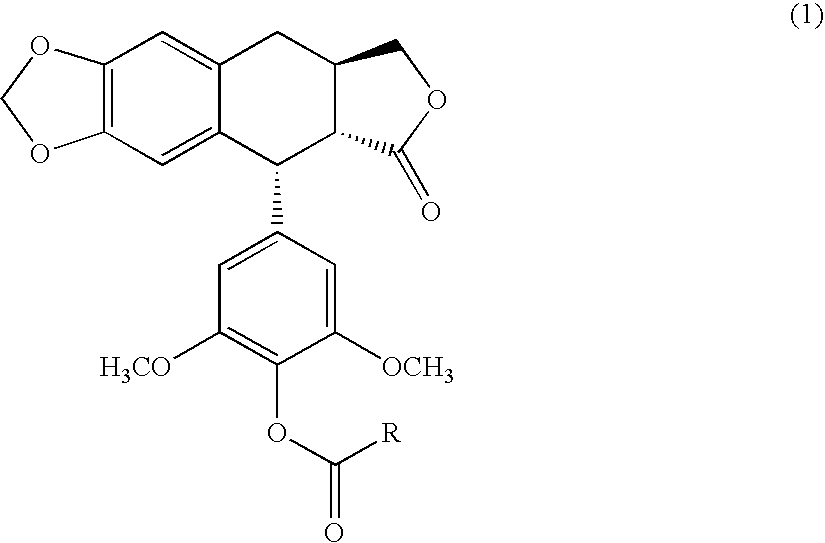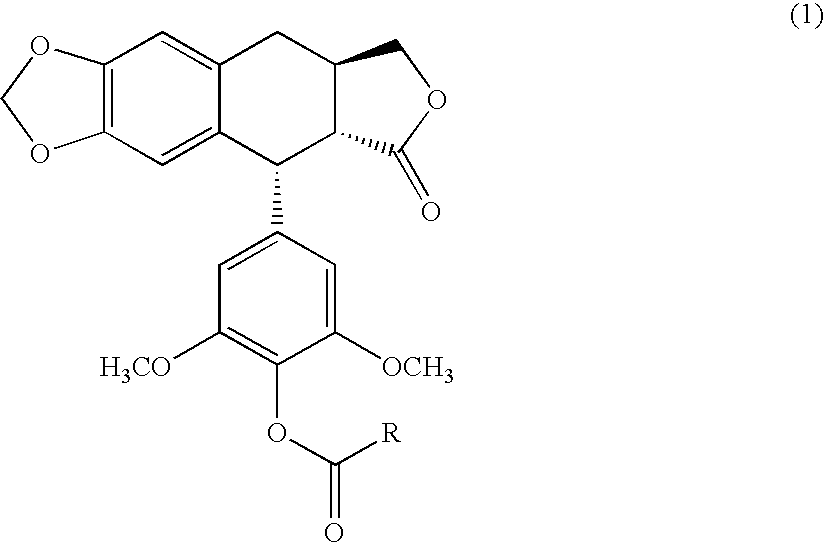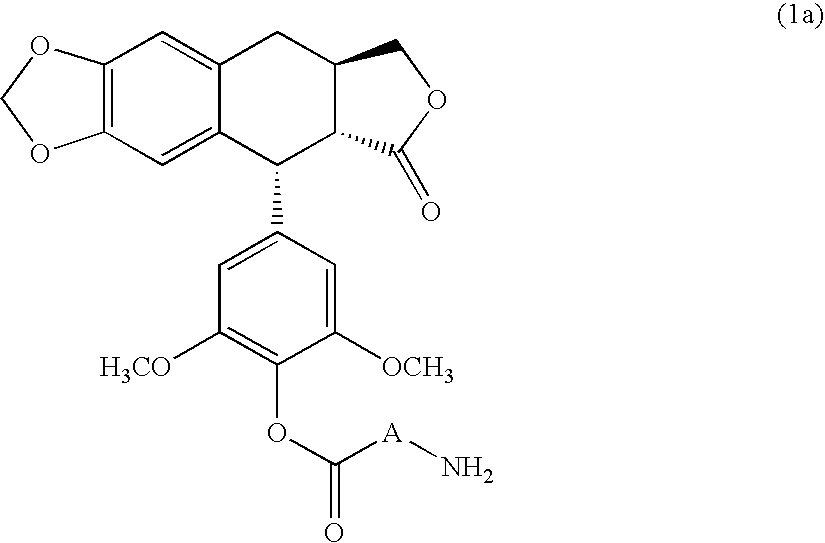4′-demethyl-4′-O-substituted-1-deoxypodophyllotoxin derivative and geometric isomer thereof, process for the preparation thereof and anti-cancer composition comprising the same
a technology of deoxypodophyllotoxin and derivative, which is applied in the direction of drug compositions, biocide, heterocyclic compound active ingredients, etc., can solve the problems of unresearched deoxypodophyllotoxin and derivatives thereof as anticancer agents, and achieve potent anticancer activity and better biocompatibility and water solubility
- Summary
- Abstract
- Description
- Claims
- Application Information
AI Technical Summary
Benefits of technology
Problems solved by technology
Method used
Image
Examples
preparation 1
Synthesis of 4′-demethyl-1-deoxypodophyllotoxin (DDPT)
[0141]4-Methoxy group of deoxypodophyllotoxin (DPT) was selectively demethylated according to a known process [see, Laurent, D. et al.; J. Med. Chem., 41, 4475-4485, 1998] to give deoxypodophyllotoxin (DPT). The reaction procedures are described in detail in the following.
[0142]Deoxypodophyllotoxin (3.98 g, 10 mmol) was dissolved in anhydrous dichloromethane (100 ml) and the temperature was adjusted to 0° C. Then, a solution of trimethylsilyl iodide (4.25 ml, 30 mmol) in anhydrous dichloromethane (10 ml) was added dropwise thereto for 30 minutes under stirring. The reactants and barium carbonate (2 g) were added to a solvent mixture (300 ml) of acetone and water (acetone:water=150 ml:150 ml) and stirred for 30 minutes. The reaction mixture was extracted with dichloromethane (200 ml). The extract was dried over anhydrous sodium sulfate and concentrated under reduced pressure. The crude product thus obtained was purified by silica ...
preparation 2
Synthesis of N-t-butyloxycarbonyl-alanine (4-1)
[0146]L-alanine (445 mg, 5 mmol) was dissolved in a solvent mixture of 1N NaOH (17 ml), distilled water (9 ml) and 1,4-dioxane (17 ml) and cooled to 0° C. Di-t-butyl dicarbonate (1.2 g, 5.5 mmol) was added for about 5 minutes bit by bit. The reaction solution was stirred for about 5 minutes at 0° C., warmed to room temperature, and then stirred for further about 2 hours. The reaction solution was concentrated under reduced pressure to remove 1,4-dioxane. To the remaining solution was added 1N-HCl to make the solution acidic. The remaining solution was extracted three times with ethyl acetate (30 ml×3). The extracts were combined, dried over anhydrous sodium sulfate, and concentrated under reduced pressure to give 850 mg of the title compound, which was not purified any more.
[0147]Yield: 90%.
[0148]1H-NMR (ppm): 10.5 (br, 1H), 5.3 (br, 1H), 4.64 (d, J=7.5 Hz, 3H), 1.48 (n, 1H), 1.46 (s, 9H).
[0149]IR (KBr, cm−1); 3390, 1755, 1710.
preparation 3
Synthesis of N-t-butyloxycarbonyl-leucine (4-2)
[0150]The same procedure as Preparation 2 was carried out except that DL-leucine (655 mg, 5 mmol) was used to give 1.06 g of the title compound.
[0151]Yield: 93%.
PUM
 Login to View More
Login to View More Abstract
Description
Claims
Application Information
 Login to View More
Login to View More - R&D
- Intellectual Property
- Life Sciences
- Materials
- Tech Scout
- Unparalleled Data Quality
- Higher Quality Content
- 60% Fewer Hallucinations
Browse by: Latest US Patents, China's latest patents, Technical Efficacy Thesaurus, Application Domain, Technology Topic, Popular Technical Reports.
© 2025 PatSnap. All rights reserved.Legal|Privacy policy|Modern Slavery Act Transparency Statement|Sitemap|About US| Contact US: help@patsnap.com



